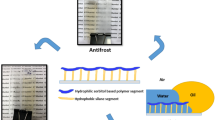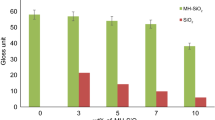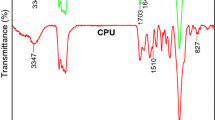Abstract
With the goal of developing a waterborne coating material that prevents staining, organic-inorganic composites prepared from colloidal silica and two types of acrylic resin emulsions were investigated as exterior coatings. conventional acrylic resin emulsion and organic silane hybridized acrylic resin emulsion prepared by emulsion polymerization were mixed with colloidal silica to form organic-inorganic comiposite films. The addition of colloidal silica to emulsions yielded films with higher hydrophilicities, as indicated by lower water contact angles for these films in comparison to films without colloidal silica. The water contact angles of organic silane hybridized acrylic resin emulsion/colloidal silica films were lower than those of acrylic resin emulsion/colloidal silica films. Composite films containing colloidal silica particles smaller than 100 nm in diameter showed high hydrophilicities. Observations of the dispersed state of colloidal silicaparticles in organic-inorganic composite films by scanning electron microscopy (SEM) and transmission electron microscopy (TEM) demonstrated that colloidal silica particles were densely aggregated on the film surface. Outdoor exposure tests of the coating materials prepared from organic silane hybridized acrylic resin and colloidal silica particles with diameters of 7.5 nm showed excellent stain resistance.
Similar content being viewed by others
References
Yoshida, M., “Ultra-Weatherability Coating Based on Acrylic Resins,” Shikizai Kyokaishi, 64 (9) 589–597 (1991).
Munekata, S., “Fluoropolymers as Coating Mateiral,” Prog. Org. Coat., 113–134 (1988).
Lau, W.W.Y., Lee, C.S., Goh, S.H., Lee, S.Y., Pan, J., and Song, Y., “Characterization of New Hindered Amine Light Stabilizers,” J. Appl. Polym. Sci., 50, 403 (1993).
Ávár, L. and Bechtold, K., “Studies on the interaction of Photoreactive Light Stabilizers and UV-Absorbers,” Prog. Org. Coat., 35, 11 (1999).
Kenmotsu, N., Kittaka, Y., Kamimura, K., Takeuchi, T., and Konishi, T., “Relation Between Soiling Behavior and Surface Properties of Building External Paints. Basic Examination on the Effects of Contact Angle, Glass Transition Temp., Hardness and Roghness (Part 1),” Summaries of Technical Papers of Annual Meeting Architectural Institute of Japan A-1 Materials and Construction, 91–92 (1992).
Kenmotsu, N., Kittaka, Y., Kamimura, K., and Konishi, T., “Relation between Soiling Behavior and Surface Properties of Building External Paints. Basic Examination on the Effects of Contact Angle, Glass Transition Temp., Hardness and Roughness (Part 2),” Summaries of Technical Papers of Annual Meeting Architectural Institute of Japan A-1 Materials and Construction, 1205–1206 (1994).
Kuzumi, A., Ando, T., Kato, Y., and Kondo, T., “Stain Resistance of Acrylosilane Coating,” Japan Society for Finishing Technology (1994).
Nakaya, T., “Development of a Staining Preventive Coating for Architecture,” Prog. Org. Coat., 27, 173 (1996).
Wei, Y., Jin, D., Wei, G., Yang, D., and Xu, J., “Novel Organic-Inorganic Chemical Hybrid Fillers for Dental Composite Mateirals,” J. Appl. Polym. Sci., 70, 1689 (1998).
Chen, J.-I., Chareonsak, R., Puengpipat, V., and Marturunkakul, S., “Organic-Inorganic Composite Materials for Coating Applications,” J. Appl. Polym. Sci., 74, 1341 (1999).
ogomi, D., Serizawa, T., and Akashi, M., “Bioinspired Organic-Inorganic Composite Materials Prepared by an Alternate Soaking Process as a Tissue Reconstitution Matrix,” J. Biomed. Mater. Res., Part A, 67A, 1360 (2003).
Uragami, T., Okazaki, K., Matsugi, H., and Miyata, T., “Structure and Permeation Characteristics of an Aqueous Ethanol Solution of Organic-Inorganic Hybrid Membranes Composed of Poly (vinyl alcohol) and Tetraethoxysilane,” Macromolecules, 35, 9156 (2002).
Uragami, T., Katayama, T., Miyata, T., Tamura, H., Shiraiwa, T., and Higuchi, A., “Dehydration of an Ethanol/Water Azeotrope by Novel Organic-Inorganic Hybrid Membranes Based on Quaternized Chitosan and Tetraethoxysilane,” Biomacromolecules, 5, 1567 (2004).
Uragami, T., Katayama, T., and Miyata, T., “Pervaporation Properties for an Azeotrope of Ethanol/Water Through Organic-Inorganic Hybrid Membranes from Quaternized Chitosan with Tetraethoxysilane,” Trans. Mater. Res. Soc. Jpn., 29, 3295 (2004).
Ohshima, T., Matsumoto, M., Miyata, T., and Uragami, T., “Organic-Inorganic Hybrid Membranes for Removal of Benzene from an Aqueous Solution by Pervaporation,” Macromol. Chem. Phys., 206, 473 (2005).
Ohshima, T., Matsumoto, M., Miyata, T., and Uragami, T., “Structural Design of P(BMA-co-VTES)/TEO Hybrid Membranes for Removal of Benzene from Water by Pervaporation,” Macromol. Chem. Phys., 206, 1638 (2005).
Uragami, T., Matsugi, M., and Miyata, T., “Pervaporation Characteristics of Organic-Inorganic Hybrid Membranes Composed of Poly(vinyl alcohol-co-acrylic acid) and Tetraethoxysilane for Water/Ethanol Separation,” Macromolecules, 38 (8), 440 (2005).
Tomita, R., Urano, S., and Kohiki, S., “Quantitative Evaluation of Hydrolysis Ratio and Content of Silicic Ester on Film Surface by X-ray Photoelectron Spectroscopy,” J. Jpn. Soc. colour Mater., 74, 460 (2001).
Tomita, R., Urano, S., and Kohiki, S., “Elucidation of Hydrophilization Mechanism on Film Surface and Design of Silicic Ester by Use of Quantitative Evaluation of Hydrolysis Ratio and Content of Silicic Ester,” J. Jpn. Soc. Colour Mater., 74, 466 (2001).
Kakui K., Murakami, N., Osawa, S., Okamoto, H., and hasegawa, T., “New Technology About the Reduction in Contamination of Ecofriendly Coatings. Development and Evaluation of Water Based High Durability and Stain Resistance Coatings,” Summaries of Technical Papers of Annual Meeting Architectural Institute of Japan A-1 Materials and Construction (2002).
Wada, T., Inui, K., and Uragami, T., “Properties of Organic-Inorganic Composite Coating Materials Prepared from Acrylic Resin Emulsions and Colloidal Silicas,” J. Appl. Polym. Sci., 101, 2951 (2006).
Motohashi, K. and Soga, M., “Evaluation of Soiling Due to Rain Trace on the Coated Layers,”. The 2002 Global Symposium, 760 (2002).
Kiryu, H. and Kasamatsu, H., Foundation and Physical Properties of High Efficient Paint, Cmc Shuppan, Japan, 1985.
Author information
Authors and Affiliations
Rights and permissions
About this article
Cite this article
Wada, T., Uragami, T. Preparation and characteristics of a waterborne preventive stain coating material with organic-inorganic composites. J Coat. Technol. Res. 3, 267–274 (2006). https://doi.org/10.1007/s11998-006-0022-5
Published:
Issue Date:
DOI: https://doi.org/10.1007/s11998-006-0022-5




